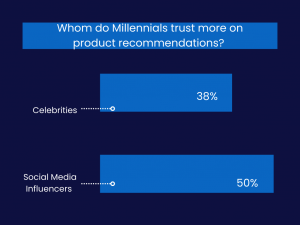
Are you ready to dive into the dynamic world of marketing where likes, shares, and follows hold more power than ever before? This is the world of social media influencing, an arena that is revolutionizing how we view marketing as a whole.
In this era of smartphones and scrolling, social media has become an irresistible force, shaping not only the way we connect and communicate but also how businesses market their products and services. Welcome to the captivating realm of social media influencing, where the power of a single post can propel a brand to new heights or send it spiraling into obscurity.
We’ll uncover the secrets behind viral campaigns, decode the enigma of the ever-elusive algorithms, and unravel the intricacies of influencer-brand collaborations. Prepare to be dazzled by the creative strategies and compelling narratives that captivate our attention and entice us to hit that coveted ‘Buy Now’ button.
It’s time to buckle up and discover the thrilling world where tweets, posts, and stories shape the fate of brands in ways we never imagined possible.
Research by Twitter and Annalect found that nearly 40% of Twitter users have made a purchase based on an influencer’s tweet.
What Is Social Media Influencing?
Social media influencing is the art of captivating hearts, capturing minds, and conquering the digital realm with a single post. It’s modern-day sorcery where ordinary individuals, armed with creativity and charisma, wield their social media accounts as mighty scepters to sway the masses.
Picture this: a vibrant tapestry of trendsetters, tastemakers, and trailblazers, using their online presence to shape opinions, spark conversations, and inspire action. These social media influencers possess an almost supernatural ability to curate content that resonates deeply with their loyal legions of followers.
It’s a breathtaking dance between the real and the virtual, where influencers seamlessly blend their personal lives with product placements, promoting brands in ways that make us salivate, click, and yearn for more. From sleek fashion ensembles to mouthwatering culinary adventures, from breathtaking travel escapades to life-changing skincare routines, these digital wizards work their magic to influence our desires, aspirations, and purchasing decisions.
But it’s not all smoke and mirrors.
Behind the perfectly-filtered images and captivating captions lies a sophisticated marketing revolution. Brands and businesses, recognizing the power of these online mavens, eagerly forge partnerships, seeking to ride the wave of their immense influence.
So, buckle up and prepare for a wild ride through the captivating world of social media influencing.
Top Niches In Social Media Influencing
Social media influencing has become a powerhouse in the realm of marketing, revolutionizing the way businesses connect with their target audience. With countless niches to choose from, influencers have found their sweet spot in captivating audiences and amplifying brand messages.
Let’s dive into the top niches in social media influencing and explore how they are making a lasting impact on the digital landscape.
Fashion
From runway-inspired outfits to style tips, fashion influencers bring a touch of glamour and inspiration to their followers’ feeds. They showcase the latest trends, share their personal style journeys, and collaborate with brands to create captivating campaigns.
Food
Food influencers tantalize our taste buds with mouthwatering recipes, restaurant recommendations, and drool-worthy food photography. They create a feast for the eyes and connect food enthusiasts from around the globe, turning meals into memorable experiences.
Tech Reviews
Tech-savvy influencers delve into the latest gadgets, gizmos, and tech trends. They break down complex features, provide insightful reviews, and offer valuable advice to tech enthusiasts, helping them make informed purchasing decisions.
Travel
Wanderlust-driven influencers transport us to breathtaking destinations, sharing their adventures, travel tips, and hidden gems. They inspire us to explore the world, ignite our sense of wonder, and make us dream of embarking on our epic journeys.
Fitness
Fitness influencers inspire us to stay active, showcasing their workout routines, providing nutrition tips, and sharing their fitness journeys. They motivate their followers to lead a healthy lifestyle and achieve their fitness goals.
These are just a few examples of the diverse niches within social media influencing. Each niche has its unique charm, attracting a dedicated community of followers who seek guidance, inspiration, and entertainment. Social media influencing has transformed marketing by bridging the gap between brands and consumers, and these niches play a vital role in this fascinating digital revolution.
So, whether you’re a fashionista, a foodie, a tech enthusiast, or an avid traveler, there’s an influencer out there who’s ready to captivate your attention and make an impact on your world.
The Battle for ‘Consumer’ Attention
How social media influencing works
Social media influencing/marketing has emerged as a powerful tool for businesses to connect with their target audience. Its key strengths lie in its ability to reach a vast number of users, facilitate two-way communication, and create personalised experiences. With social media platforms like Facebook, Instagram, Twitter, and LinkedIn, businesses can leverage advanced targeting options to reach specific demographics, interests, and behaviours.
One of the key advantages of social media marketing is its cost-effectiveness. Compared to traditional marketing channels such as television, radio, and print advertising, social media platforms offer more affordable advertising options. This allows businesses of all sizes to allocate their marketing budgets strategically and achieve a higher return on investment (ROI).
Moreover, social media marketing thrives on engagement. It enables businesses to interact directly with their audience through comments, likes, shares, and messages. This fosters brand loyalty, builds trust, and creates a sense of community. Influencers, who have gained significant traction on social media platforms, play a crucial role in amplifying brand messages and driving consumer engagement.
How traditional marketing works…or does it anymore?
Traditional marketing methods have long been the cornerstone of advertising, relying on mediums like television, radio, print, billboards, and direct mail. These methods have stood the test of time and continue to hold value, particularly in reaching broad audiences and building brand awareness.
The advantage of traditional marketing lies in its wide reach and familiarity. Television and radio commercials, for instance, have the potential to capture the attention of a massive audience simultaneously, allowing businesses to target a broad spectrum of potential customers. Print media, such as newspapers and magazines, also have a loyal readership that can be tapped into effectively.
Furthermore, traditional marketing offers tangible experiences. Billboards, for instance, provide a visual presence that can make a lasting impression on commuters. Direct mail, although often overlooked in the digital age, can still deliver personalised and targeted messages straight to consumers’ mailboxes.
Challenges and limitations faced
While both social media marketing and traditional marketing have their merits, they also face unique challenges. Social media marketing, for instance, is highly dynamic and ever-evolving. Algorithms change, trends shift, and platform popularity fluctuates. This necessitates continuous adaptation and staying abreast of the latest strategies and tools.
On the other hand, traditional marketing faces challenges in accurately measuring ROI. Unlike social media marketing, which offers precise tracking and analytics, traditional methods often rely on estimated reach and engagement. Additionally, traditional marketing may struggle to connect with younger generations who are increasingly spending more time on social media platforms.
Science at play

The science behind social media influencing involves understanding human behaviour, communication, persuasion, and the dynamics of social networks. Here are some key scientific aspects of social media influencing.
Social Psychology
Influencers tap into principles of social psychology to connect with their audience. They often build a sense of social identity and belonging, creating a bond between themselves and their followers. Influencers leverage concepts like social proof – people are more likely to adopt behaviours that they see others doing and liking. People are influenced by those they ‘like’ to gain trust and credibility.
Behavioural Economics
Behavioural economics studies how individuals make decisions and choices, often driven by cognitive biases. Influencers use various techniques, such as scarcity (limited-time offers) and loss aversion (fear of missing out), to drive engagement and motivate their audience to take action
Content Marketing
Social media influencers are essentially content creators, and content marketing principles play a significant role in their success. Understanding the target audience, crafting compelling storytelling, and providing value through informative or entertaining content are all essential components of effective social media influencing.
Network Theory
The study of social networks helps in understanding how information and influence spread through online communities. Influencers aim to maximize their reach and impact by strategically engaging with their followers and encouraging sharing and interactions within their network.
Cognitive Neuroscience
While not directly applied by influencers themselves, cognitive neuroscience research helps to understand how the brain processes and responds to different types of content, emotions, and stimuli, providing insights into the effectiveness of various influencer strategies.

Insight by Morning Consult on Influencers
Conclusion
In conclusion, the transformative power of social media influencing the world of marketing is undeniable. It has revolutionised the way businesses connect with their target audience, bringing forth new opportunities and challenges.
Social media marketing offers personalised experiences, advanced targeting options, and cost-effectiveness, enabling businesses to engage directly with their audience and foster brand loyalty. Traditional marketing, on the other hand, boasts wide reach, familiarity, and tangible experiences, capturing the attention of broad audiences.
However, both approaches face their own set of challenges, with social media marketing requiring continuous adaptation to evolving trends and algorithms, while traditional marketing struggles with accurate ROI measurement and connecting with younger generations.
Also read the blog – Brands meet Social Influencer Marketing Platforms.
Ultimately, a well-rounded marketing strategy that combines the strengths of both social media marketing and traditional marketing is crucial for businesses to effectively reach and engage their target audience. As the digital landscape continues to evolve, social media influence will play an increasingly vital role in shaping the future of marketing, providing a dynamic platform for businesses to connect, inspire, and influence consumer behaviour.




